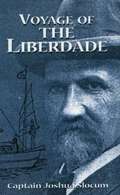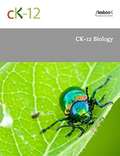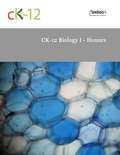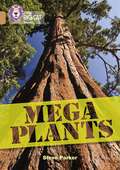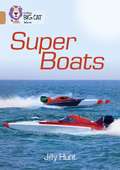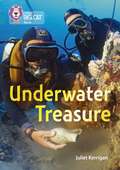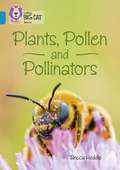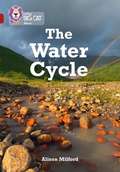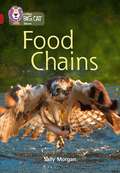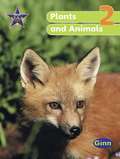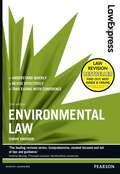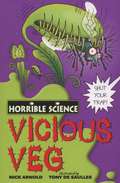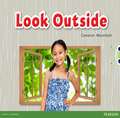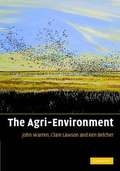- Table View
- List View
Se-Quo-Yah
by George Everett FosterPublished in 1885, this is the biography of famed Cherokee Indian, Se-Quo-Yah, the inventor of the Cherokee alphabet.
Travels in the Interior of America
by John BradburyInteresting notes about the country in early times.
La isla del tesoro
by Robert Louis StevensonLa isla del tesoro (1883), una vibrante historia sobre la búsqueda de un tesoro enterrado, presenta el bien bajo la forma de Jim, un niño que se ve envuelto en la aventura y que a su vez debe descubrir por sí mismo la cara del bien y del mal entre sus bondadosos amigos y los piratas Pew y Long John Silver.
Voyage of the Liberdade
by Joshua SlocumIn 1890, the author became the first person to circumnavigate the globe alone. This is the account of one of his lesser-known but no less remarkable sea journeys. From the Publisher: Great 19th-century mariner's thrilling, account of the wreck of his ship off the coast of South America, the 35-foot brave little craft he built from the wreckage, and its remarkable, danger-fraught voyage home. A 19th-century maritime classic brimming with courage, ingenuity, and daring. Easy-to-read and fast-paced.
CK-12 Biology I (with image descriptions)
by Ck-12 FoundationOpen source biology textbook from CK-12.
CK-12 Biology I - Honors
by Ck-12 FoundationCK-12 Foundation's Biology 1- Honors FlexBook Covers the following chapters:<P><P> Foundations of Life Science- scientific investigations, methods, observations, & communication.<P> Chemical Basis of Life- matter, the significance of carbon, lipids, proteins.<P> Cell Structure and Function- prokaryotic, eukaryotic, plant, & animal cell features; structures / functions of DNA, RNA, protein, cell transport, homeostasis.<P> Photosynthesis- water, carbon, and nitrogen cycle between abiotic and biotic resources.<P> Cellular Respiration- relation to glycolysis, Krebs Cycle, electron transport chain.<P> Cell Division and Reproduction- cell division, reproduction.<P> Mendelian Genetics- inheritance, sex-linked traits.<P> Molecular Genetics- DNA, RNA, protein synthesis, mutation, regulating gene expression.<P> Human Genetics- human genome, diseases, Biotechnology- DNA technology, gene cloning.<P> History of Life- evolution, macroevolution, extinctions, episodic speciation, response to change.<P> Evolutionary Theory- Darwin's Theory of Evolution, common ancestry and natural selection.<P> Evolution in Populations- genetics of populations, genetic diseases, natural selection.<P> Classification- Taxonomy, scientific classification of organisms.<P> Principles of Ecology- Ecology's relation with energy; ecosystems, the water, carbon, and nitrogen cycles.<P> Biomes, Ecosystems and Communities- terrestrial/ aquatic biomes, community interactions.<P> Populations- Analysis of populations and dynamics.<P> Ecology and Human Actions- Balance between humans and the earth addressing natural resources, ecosystems, & biodiversity.<P> The Human Body- systems.<P> Nervous and Endocrine Systems- structures & functions, homeostasis.<P> Skeletal, Muscular, and Integumentary Systems- structures, functions, & homeostasis.<P> Circulatory and Respiratory Systems- structures and functions.<P> Digestive and Excretory Systems- structures/ functions, food pyramid.<P> Immune System and Disease- Body defenses against pathogens.<P> Reproductive System and Human Development- human reproductive systems, reproductive lifecycle, STDs.
Offshore Fishes of California
by John E. FitchThe California angler who pursues his chosen sport in the waters of the blue Pacific is, without a doubt, one of the luckiest fishermen in the world. The more than 1,000 miles of ocean shoreline that extend from San Diego to Crescent City (Mexico to Oregon) offer in combination a greater variety of fish and fish habitat, a more extensive fishing area, a better choice of excellent boat launching sites, and a wider selection of highly skilled sport-fishing boat operators than are to be found along any similar stretch of coast anywhere in the world.
عمدة الطبيب في معرفة النبات
by يحيى مراددراسة التراث وتاريخ العلوم عند العرب والمسلمين، أمر لابدّ منه في مرحلة التحوّل التي تمر بها الأمة العربية. ذلك لأن اطلاع أبنائها على المنجزات العلمية التي حققها الأجداد في الماضي، لابدّ أن يكون باعثاً على الثقة في النفوس، وحافزاً لحث الخطى في طريق التقدم العلمي والتقني الذي نسعى لتحقيقه. ومن واجب التراث علينا أن نتصدى بأنفسنا لكشف مكنوناته، ونشر روائعه، وإلقاء الضوء على مدى مساهمته في إغناء المعرفة والعلم خلال قرون عديدة، بعد أن ظل هذا العمل مقتصراً على المستشرقين الذين ينتمون إلى أمم مختلفة. وفي مكتباتنا العربية العامة والخاصة كثير من المخطوطات القيّمة، والكتب النافعة التي لم تدرس حتى الآن، ولاسيّما في موضوع الطب والصيدلة وعلم النبات والتي كان لها سماتها، فأدت دوراً كبيراً في إثراء العلوم وبث روح الحياة. حيث كان يلتقي النبات والدواء في مسيرة واحدة لتأمين الغذاء النافع والدواء الناجع. لقد توافرت للعرب ثروة معرفيّة ولغويّة هائلة حين انصرفوا إلى الطبيعة، كغيرهم من الأمم التي سبقتهم، فوجدوا أن الأرض تزخر بالخيرات، من شجر وعشب وبقل وتابل وغذاء، فانصرفوا إلى "علم الفلاحة" ودراسة النباتات. وألّفوا في ذلك كتباً كثيرة لها أهميتها في ميادين علوم النبات والصيدلة والطب وغيرها. وكانت عنايتهم بأصناف النبات نابعة من حاجتهم إلى الغذاء والدواء معاً. وإلى التطيب بالعطور، وصناعة الصباغة والدباغة، وتركيب المواد الصيدلانية من جذور وقشور وثمار وبذور وأعشاب نباتات مختلفة. وهكذا أصبحت المعاجم العربية، والمؤلفات العلمية، غنية بكم وافر من الأسماء والمصطلحات النباتية، وضمَّت معارف العرب المسلمين القدماء في علمي الطب والنبات. فكانت مصدراً لمن ألف وكتب في المفردات النباتية والغذائية والدوائية. وهي كثيرة العدد نذكر منها: "كتاب النبات" لأبي حنيفة الدينوري(1) ت 282هـ-895م)، وكان من أكثر المعاجم جمعاً للمادة، وأعظمها أثراً في معاجم النبات التي ألفت فيما بعد.
Collins Big Cat,Band 12,Copper: Mega Plants (PDF)
by Steve ParkerPlants are amazing, different around the world - and the biggest living things ever. There are leaves twice as long as a bus, flowers that attract insects by smelling like dead bodies, and trees that grow taller than the Statue of Liberty or weigh ten times as much as a blue whale! * Copper/Band 12 books provide more complex plots and longer chapters that develop reading stamina. * Text type - An information book. * The book is organised into short chapters to help children practise the skills of locating and identifying important information. * The glossary and index on pages 30 and 31 can be used to develop children's information retrieval skills further. * Curriculum links - Science
Collins Big Cat, Band 12/Copper: Super Boats (PDF)
by Jilly HuntSailing, racing, travel and cargo - boats have many different uses. But some are just designed for fun! Read about boats that can travel faster than the wind, sail around the world and even some boats that have swimming pools and discos on them! * Copper/Band 12 books provide more complex plots and longer chapters that develop reading stamina. * Text type - An information book. * The book is organised into short chapters to help children practise the skills of locating and identifying important information. * The glossary and index on pages 30 and 31 can be used to develop children's information retrieval skills further.
Collins Big Cat, Band 13/Topaz: Underwater Treasure (PDF)
by Juliet KerriganDive under the water and discover lost treasures! Sunken ships, gold coins, giant statues and a drowned city are all waiting to be found. . . * Topaz/Band 13 books offer longer and more demanding reads for children to investigate and evaluate. * An information book. * Curriculum links: history, geography, science
Title: Plants, Pollen and Pollinators (PDF)
by Becca HeddleYou probably know that bees and butterflies help to pollinate flowers. But did you also know that beetles, lizards and small mammals are also good pollinators? Read more about the animals that help to pollinate flowers - you might be surprised by what you find! * Topaz/Band 13 books offer longer and more demanding reads for children to investigate and evaluate. * An information book. * Curriculum Links: science
Collins Big Cat, Band 14/Ruby: The Water Cycle (PDF)
by Alison MilfordWe all need water to survive - without it there would be no life on Earth! Find out how the Earth recycles water, and what we can do to help. * Ruby/Band 14 books give increasing opportunities for children to develop their skills of inference and deduction. * Text type: An information book * Curriculum links: science, geography
Collins Big Cat, Band 14/Ruby: Food Chains (PDF)
by Sally MorganAll living things need food to survive. Find out who eats whom, and how we all link together to form a food chain. • Ruby/Band 14 books give increasing opportunities for children to develop their skills of inference and deduction. • Text type: an information book • Curriculum links: science, geography
Plants and Animals 2: Pupil's Book (PDF)
by John Stringer Roy Phipps Rosemary Feasey Anne GoldsworthyProviding a solution for teaching infant science, New Star Science 2 books are aimed at the second primary school year. This Pupil's Book provides practical tasks and activities, with work throughout the topic and support for group activities. The topic covered is plants and animals.
Environmental Law (PDF)
by Simon SneddonThe Law Express series is designed to help you revise effectively. This book is your guide to understanding essential concepts, remembering and applying key legislation and making your answers stand out
Vicious Veg (PDF)
by Nick Arnold Tony De SaullesScience with the squishy bits left in! How do plants suck out the insides of dead insects? Why do stinging nettles like skeletons? Which fungi can make your toes drop off? Get the awful answers in Vicious Veg!
The Agri-environment (PDF)
by John Warren Clare Lawson Kenneth Belcher Kenneth Ward BelcherThe application of ecological theory and conservation biology to agricultural ecosystems has become an important and growing research field and undergraduate course component in recent years. This book is both an academic textbook and practical guide to farm conservation, and has evolved from the authors' extensive teaching experience. It covers the ecology of farmed land, how agricultural practices influence the environment, how agriculture has changed over time and how the species that inhabit the agri-environment have adapted. It also covers the history of agricultural policy and subsidies and the development of agri-environment schemes. A number of different farming systems are discussed, as are the difficulties in determining their relative merits. Guidance is offered on how to produce a workable farm conservation plan, and the final chapters look to the future and the development of new, greener farming systems. ISBN: 9780521849654 hardback ISBN: 9780521614887 paperback

